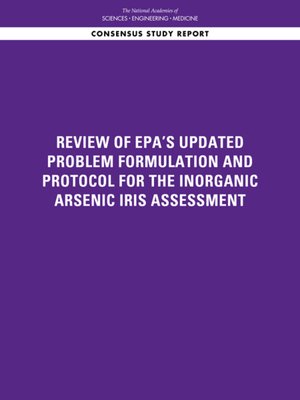Review of EPA's Updated Problem Formulation and Protocol for the Inorganic Arsenic IRIS Assessment
ebook
By National Academies of Sciences, Engineering, and Medicine

Sign up to save your library
With an OverDrive account, you can save your favorite libraries for at-a-glance information about availability. Find out more about OverDrive accounts.
Find this title in Libby, the library reading app by OverDrive.



Search for a digital library with this title
Title found at these libraries:
| Library Name | Distance |
|---|---|
| Loading... |
The Integrated Risk Information System (IRIS) is a program within the US Environmental Protection Agency (EPA) that is responsible for developing toxicologic assessments of environmental contaminants. An IRIS assessment contains hazard identifications and dose-response assessments of various chemicals related to cancer and noncancer outcomes. Although the program was created to increase consistency among toxicologic assessments within the agency, federal, state, and international agencies and other organizations have come to rely on IRIS assessments for setting regulatory standards, establishing exposure guidelines, and estimating risks to exposed populations.
The EPA has been working on its IRIS assessment of inorganic arsenic (iAs) for many years, and recently released its plans for completing it in the Updated Problem Formulation and Protocol for the Inorganic Arsenic IRIS Assessment. Much of the update was made in response to recommendations in a 2013 report made by the National Academies of Sciences, Engineering, and Medicine. The National Academies recently convened another evaluation of whether the various elements of the IRIS iAs assessment plan are appropriate to synthesize the scientific evidence and quantitate estimates of iAs toxicity. Review of EPA's IRIS Assessment Plan for Inorganic Arsenic explores the EPA's approach to prioritizing health outcomes, EPA's systematic review methods, EPA's consideration of potential health effects from early life exposures, mode-of-action information to inform dose-response analyses, and various approaches to investigate dose-response relationships.







